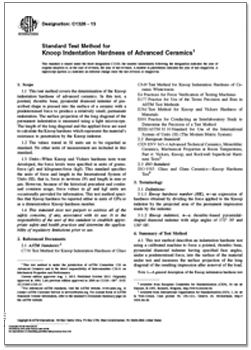英文名称:
ASTM C1326-13
Standard Test Method for
Knoop Indentation Hardness of Advanced Ceramics
中文名称:
ASTM C1326-13
现代陶瓷材料努氏压痕硬度的标准试验方法
代号说明:
This standard is issued under the fixed designation C1326; the number immediately following the designation indicates the year of original adoption or, in the case of revision, the year of last revision. A number in parentheses indicates the year of last reapproval. A superscript epsilon (ε) indicates an editorial change since the last revision or reapproval.
版本说明:
1 This test method is under the jurisdiction of ASTM Committee C28 on Advanced Ceramics and is the direct responsibility of Subcommittee C28.01 on Mechanical Properties and Performance.
Current edition approved Aug. 1, 2013. Published October 2013. Originally approved in 1996. Last previous edition approved in 2008 as C1326–08ε1 . DOI:10.1520/C1326-13.
2 For referenced ASTM standards, visit the ASTM website, www.astm.org, or contact ASTM Customer Service at service@astm.org. For Annual Book of ASTM Standards volume information, refer to the standard’s Document Summary page on the ASTM website.
3 Available from European Committee for Standardization (CEN), 36 rue de Stassart, B-1050, Brussels, Belgium, http://www.cenorm.be.
4 Available from International Organization for Standardization (ISO), 1, ch. de la Voie-Creuse, Case postale 56, CH-1211, Geneva 20, Switzerland, http://www.iso.ch.
5 The boldface numbers in parentheses refer to the list of references at the end of this test method.
6 Standard Reference Materials Program (NIST) 100 Bureau Drive, Stop 2300 Gaithersburg, MD 20899-2300.
标准正文:
1. Scope
1.1 This test method covers the determination of the Knoop indentation hardness of advanced ceramics. In this test, a pointed, rhombic base, pyramidal diamond indenter of prescribed shape is pressed into the surface of a ceramic with a predetermined force to produce a relatively small, permanent indentation. The surface projection of the long diagonal of the permanent indentation is measured using a light microscope. The length of the long diagonal and the applied force are used to calculate the Knoop hardness which represents the material's resistance to penetration by the Knoop indenter.
1.2 The values stated in SI units are to be regarded as standard. No other units of measurement are included in this standard.
1.3 Units—When Knoop and Vickers hardness tests were developed, the force levels were specified in units of gramsforce (gf) and kilograms-force (kgf). This standard specifies
the units of force and length in the International System of Units (SI); that is, force in newtons (N) and length in mm or µm. However, because of the historical precedent and continued common usage, force values in gf and kgf units are occasionally provided for information. This test method specifies that Knoop hardness be reported either in units of GPa or as a dimensionless Knoop hardness number.
1.4 This standard does not purport to address all of the safety concerns, if any, associated with its use. It is the responsibility of the user of this standard to establish appropriate safety and health practices and determine the applicability of regulatory limitations prior to use.
2. Referenced Documents
2.1 ASTM Standards:
C730 Test Method for Knoop Indentation Hardness of Glass
C849 Test Method for Knoop Indentation Hardness of Ceramic Whitewares
E4 Practices for Force Verification of Testing Machines
E177 Practice for Use of the Terms Precision and Bias in ASTM Test Methods
E384 Test Method for Knoop and Vickers Hardness of Materials
E691 Practice for Conducting an Interlaboratory Study to Determine the Precision of a Test Method
IEEE/ASTM SI 10 Standard for Use of the International System of Units (SI) (The Modern Metric System)
2.2 European Standard:
CEN ENV 843-4 Advanced Technical Ceramics, Monolithic Ceramics, Mechanical Properties at Room Temperature,
Part 4: Vickers, Knoop, and Rockwell Superficial Hardness Tests
2.3 ISO Standard:
ISO 9385 Glass and Glass Ceramics—Knoop Hardness Test
3. Terminology
3.1 Definitions:
3.1.1 Knoop hardness number (HK), n—an expression of hardness obtained by dividing the force applied to the Knoop indenter by the projected area of the permanent impression
made by the indenter.
3.1.2 Knoop indenter, n—a rhombic-based pyramidalshaped diamond indenter with edge angles of 172° 30' and 130° 00'.
在线阅读 免费下载







